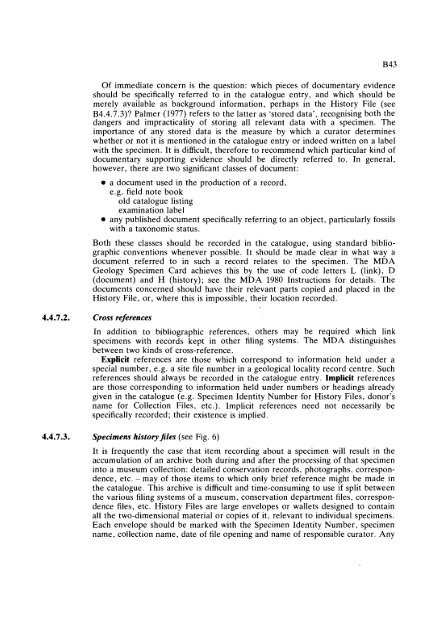GUIDELINES FOR THE CURATION OF GEOLOGICAL MATERIALS
GUIDELINES FOR THE CURATION OF GEOLOGICAL MATERIALS
GUIDELINES FOR THE CURATION OF GEOLOGICAL MATERIALS
Create successful ePaper yourself
Turn your PDF publications into a flip-book with our unique Google optimized e-Paper software.
Of immediate concern is the question: which pieces of ,documentary evidence<br />
should be specifically referred to in the catalogue entry, and which should be<br />
merely available as background information, perhaps in the History File (see<br />
B4.4.7.3)? Palmer (1977) refers to the latter as 'stored data', recognising both the<br />
dangers and impracticality of storing all relevant data with a specimen. The<br />
importance of any stored data is the measure by which a curator determines<br />
whether or not it is mentioned in the catalogue entry or indeed written on a label<br />
with the specimen. It is difficult, therefore to recommend which particular kind of<br />
documentary supporting evidence should be directly referred to. In general,<br />
however, there are two significant classes of document:<br />
m a document used in the production of a record,<br />
e.g. field note book <br />
old catalogue listing <br />
examination label <br />
m any published document specifically referring to an object, particularly fossils<br />
with a taxonomic status.<br />
Both these classes should be recorded in the catalogue, using standard bibliographic<br />
conventions whenever possible. It should be made clear in what way a<br />
document referred to in such a record relates to the specimen. The MDA<br />
Geology Specimen Card achieves this by the use of code letters L (link), D<br />
(document) and H (history); see the MDA 1980 Instructions for details. The<br />
documents concerned should have their relevant parts copied and placed in the<br />
History File, or, where this is impossible, their location recorded.<br />
4.4.7.2. Cross references<br />
In addition to bibliographic references, others may be required which link<br />
specimens with records kept in other filing systems. The MDA distinguishes<br />
between two kinds of cross-reference.<br />
Explicit references are those which correspond to information held under a<br />
special number, e.g. a site file number in a geological locality record centre. Such<br />
references should always be recorded in the catalogue entry. Implicit references<br />
are those corresponding to information held under numbers or headings already<br />
given in the catalogue (e.g. Specimen Identity Number for History Files, donor's<br />
name for Collection Files, etc.). Implicit references need not necessarily be<br />
specifically recorded; their existence is implied.<br />
4.4.7.3. Specimens historyfiles (see Fig. 6)<br />
It is frequently the case that item recording about a specimen will result in the<br />
accumulation of an archive both during and after the processing of that specimen<br />
into a museum collection: detailed conservation records, photographs, correspondence,<br />
etc. -may of those items to which only brief reference might be made in<br />
the catalogue. This archive is difficult and time-consuming to use if split between<br />
the various filing systems of a museum, conservation department files, correspondence<br />
files, etc. History Files are large envelopes or wallets designed to contain<br />
all the two-dimensional material or copies of it, relevant to individual specimens.<br />
Each envelope should be marked with the Specimen Identity Number, specimen<br />
name, collection name, date of file opening and name of responsible curator. Any

















